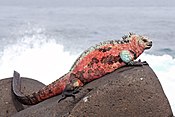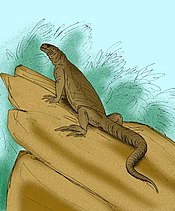Superregnum: Eukaryota
Cladus: Unikonta
Cladus: Opisthokonta
Cladus: Holozoa
Regnum: Animalia
Subregnum: Eumetazoa
Cladus: Bilateria
Cladus: Nephrozoa
Superphylum: Deuterostomia
Phylum: Chordata
Subphylum: Vertebrata
Infraphylum: Gnathostomata
Megaclassis: Osteichthyes
Cladus: Sarcopterygii
Cladus: Rhipidistia
Cladus: Tetrapodomorpha
Cladus: Eotetrapodiformes
Cladus: Elpistostegalia
Superclassis: Tetrapoda
Cladus: Reptiliomorpha
Cladus: Amniota
Classis: Reptilia
Cladus: Eureptilia
Cladus: Romeriida
Subclassis: Diapsida
Cladus: Sauria
Infraclassis: Lepidosauromorpha
Superordo: Lepidosauria
Ordo: Squamata
Cladus: Unidentata Episquamata Toxicofera
Subordo: Iguania
Infraordo: Pleurodonta
Familia: Iguanidae
Genera: Amblyrhynchus – Brachylophus – Conolophus – Ctenosaura – Cyclura – Dipsosaurus – Iguana – Sauromalus – †Armandisaurus – †Lapitiguana – †Oreithyia – †Pumila
Name
Iguanidae Oppel, 1811
Vernacular names
беларуская: Ігуанавыя
čeština: Leguánovití
Deutsch: Leguane
English: Iguanidae
suomi: Leguaanit
français: Iguane
italiano: Iguanidae
日本語: イグアナ科
lietuvių: Iguanos
македонски: Игуани
Nederlands: Leguanen
polski: Legwanowate
português: Iguanidae
русский: Игуановые
svenska: Leguaner
ไทย: อีกัวนา
The Iguanidae is a family of lizards composed of the iguanas, chuckwallas, and their prehistoric relatives,[1] including the widespread green iguana.
Taxonomy
Iguanidae is thought to be the sister group to the collared lizards (family Crotaphytidae); the two groups likely diverged during the Late Cretaceous, as that is when Pristiguana and Pariguana, the two earliest fossil genera, are known from. The subfamily Iguaninae, which contains all modern genera, likely originated in the earliest Paleocene, at about 62 million years ago. The most basal extant genus, Dipsosaurus, diverged from the rest of Iguaninae during the late Eocene, about 38 million years ago, with Brachylophus following a few million years later at about 35 million years ago, presumably after its dispersal event to the Pacific. All other modern iguana genera formed in the Neogene period.[2]
A phylogenetic tree of Iguaninae is shown here:[2]
|
Description
Iguanas and iguana-type species are diverse in terms of size, appearance, and habitat. They typically flourish in tropical, warm climates, such as regions of South America and islands in the Caribbean and in the Pacific. Iguanas typically possess dorsal spines across their back, a dewlap on the neck, sharp claws, a long whip-like tail, and a stocky, squat build. Most iguanas are arboreal, living in trees, but some species tend to be more terrestrial, which means they prefer the ground. Iguanas are typically herbivores and their diets vary based on what plant life is available within their habitat. Iguanas across many species remain oviparious, and exhibit little to no parental care when their eggs hatch. They do, however, display nest-guarding behavior. Like all reptiles, they are poikilothermic, and also rely on regular periods of basking under the sun to thermoregulate.[3]
Distribution
All but one of modern iguana genera are native to the Americas, ranging from the deserts of the Southwestern United States through Mexico, Central America, and the Caribbean, to throughout South America down to northernmost Argentina. Some iguanas like I. iguana have spread from their native regions of Central and South America into many Pacific Islands, and even to Fiji, Japan, and Hawai'i, due to the exotic pet trade and illegal introductions into the ecosystems.[4] Other iguanas, like the Galapagos pink iguana (C. marthae) are endemic only to specific regions on the Galapagos islands. The Grand Cayman blue iguana, C. lewisi, is endemic only to the Grand Cayman island, limited to a small wildlife reserve.[3] The only non-American iguana species are the members of the genus Brachylophus and the extinct Lapitiguana, which are found on Fiji and formerly Tonga; their distribution is thought to be the result of the longest overwater dispersal event ever recorded for a vertebrate species, with them rafting over 8000 km across the Pacific from the Americas to the Fiji and Tonga.[5]
Extant genera
| Image | Genus | Species |
|---|---|---|
 |
Amblyrhynchus Bell, 1825 – marine iguana |
|
 |
Brachylophus Cuvier, 1829 – Fijian/Tongan iguanas |
|
.jpg/175px-Ctenosaura_defensor_(6138652398).jpg) |
Cachryx Cope, 1866 – spinytail iguanas |
|
.jpg/175px-Conolophus_subcristatus_(North_Seymour_1).jpg) |
Conolophus Fitzinger, 1843 – Galápagos land iguanas |
|
.jpg/175px-Black_Spiny-tailed_Iguana_(16422875267).jpg) |
Ctenosaura Wiegmann, 1828 – spinytail iguanas |
|
 |
Cyclura – West Indian rock iguanas |
|
;_Cholla_Cactus_Garden.jpg/175px-Desert_Iguana_(Dipsosaurus_dorsalis);_Cholla_Cactus_Garden.jpg) |
Dipsosaurus Hallowell, 1854 |
|
 |
Iguana Laurenti, 1768 – green and Lesser Antillean iguanas |
|
_at_White_Tank_Campground_(21867603086).jpg/175px-Chuckwalla_(Sauromalus_ater)_at_White_Tank_Campground_(21867603086).jpg) |
Sauromalus Dumeril, 1856 – chuckwallas |
|
Fossils
| Image | Genus | Species |
|---|---|---|
 |
Armandisaurus Norell & de Queiroz, 1991 |
|
 |
Lapitiguana Pregill & Worthy, 2003 |
|
 |
Pumilia Norell 1989 |
|
| Pristiguana Estes & Price 1973 |
|
|
| Pariguana Longrich et al., 2012 |
|
Classification
Several classification schemes have been used to define the structure of this family. The "historical" classification recognized all New World iguanians, plus Brachylophus and the Madagascar oplurines, as informal groups and not as formal subfamilies.[6]
Frost and Etheridge (1989) formally recognized these informal groupings as families.[7][8]
Macey et al. (1997), in their analysis of molecular data for iguanian lizards recovered a monophyletic Iguanidae and formally recognized the eight families proposed by Frost and Etheridge (1989) as subfamilies of Iguanidae.[9]
Schulte et al. (2003) reanalyzed the morphological data of Frost and Etheridge in combination with molecular data for all major groups of Iguanidae and recovered a monophyletic Iguanidae, but the subfamilies Polychrotinae and Tropidurinae were not monophyletic.[10]
Townsend et al. (2011), Wiens et al. (2012) and Pyron et al. (2013), in the most comprehensive phylogenies published to date, recognized most groups at family level, resulting in a narrower definition of Iguanidae.[11][12][13]
Historical classification
Family Iguanidae
Informal grouping anoloids: anoles, leiosaurs, Polychrus
Informal grouping basiliscines: casquehead lizards
Informal grouping crotaphytines: collared and leopard lizards
Informal grouping iguanines: marine, Fijian, Galapagos land, spinytail, rock, desert, green, and chuckwalla iguanas
Informal grouping morunasaurs: wood lizards, clubtails
Informal grouping oplurines: Madagascan iguanids
Informal grouping sceloporines: earless, spiny, tree, side-blotched and horned lizards
Informal grouping tropidurines: curly-tailed lizards, South American swifts, neotropical ground lizards
Frost et al. (1989) classification of iguanas
Family Corytophanidae
Family Crotaphytidae
Family Hoplocercidae
Family Iguanidae
Genus Amblyrhynchus – marine iguana
Genus Brachylophus – Fijian/Tongan iguanas
Genus Cachryx – spinytail iguanas
Genus Conolophus – Galápagos land iguanas
Genus Ctenosaura – spinytail iguanas
Genus Cyclura – West Indian rock iguanas
Genus Dipsosaurus – desert iguana
Genus Iguana – green and Lesser Antillean iguanas
Genus Sauromalus – chuckwallas
Genus Armandisaurus (extinct chuckwalla)
Genus Lapitiguana (extinct giant Fijian iguana)
Genus Pumilia (extinct Palm Springs iguana)
Genus Pristiguana (Cretaceous Brazilian iguana)
Family Opluridae
Family Phrynosomatidae
Family Polychridae
Family Tropiduridae
Macey et al. (1997) classification of Iguanidae
Family Iguanidae
Subfamily Corytophaninae: casquehead lizards
Subfamily Crotaphytinae: collared and leopard lizards
Subfamily Hoplocercinae: wood lizards, clubtails
Subfamily Iguaninae: marine, Fijian, Galapagos land, spinytail, rock, desert, green, and chuckwalla iguanas
Subfamily Oplurinae: Madagascan iguanids
Subfamily Phrynosomatinae: earless, spiny, tree, side-blotched and horned lizards
Subfamily Polychrotinae: anoles, leiosaurs, Polychrus
Subfamily Tropidurinae: curly-tailed lizards, neotropical ground lizards, South American swifts
Schulte et al. (2003) classification of Iguanidae
Here families and subfamilies are proposed as clade names, but may be recognized under the traditional Linnean nomenclature.
Iguanidae
Corytophaninae: casquehead lizards
Crotaphytinae: collared and leopard lizards
Hoplocercinae: wood lizards, clubtails
Iguaninae: marine, Fijian, Galapagos land, spinytail, rock, desert, green, and chuckwalla iguanas
Oplurinae: Madagascan iguanids
Phrynosomatinae: earless, spiny, tree, side-blotched and horned lizards
Polychrotinae: anoles, leiosaurs, Polychrus
subclade of Polychrotinae Anolis: anoles
subclade of Polychrotinae Leiosaurini: leiosaurs
subclade of Leiosaurini Leiosaurae:
subclade of Leiosaurini Anisolepae:
subclade of Polychrotinae Polychrus
Tropidurinae: curly-tailed lizards, neotropical ground lizards, South American swifts
subclade of Tropidurinae Leiocephalus: curly-tailed lizards
subclade of Tropidurinae Liolaemini: South American swifts
subclade of Tropidurinae Tropidurini: neotropical ground lizards
Townsend et al. (2011), Wiens et al. (2012) and Pyron et al. (2013) classification of Iguanidae
Family Corytophanidae
Family Crotaphytidae
Family Dactyloidae
Family Hoplocercidae
Family Iguanidae
Family Leiocephalidae
Family Leiosauridae
Family Liolaemidae
Family Opluridae
Family Phrynosomatidae
Family Polychrotidae
Family Tropiduridae
References
Bauer, Aaron M. (1998). Cogger, H.G.; Zweifel, R.G. (eds.). Encyclopedia of Reptiles and Amphibians. San Diego: Academic Press. pp. 140–142. ISBN 0-12-178560-2.
Malone, Catherine L.; Reynoso, Víctor Hugo; Buckley, Larry (2017-10-01). "Never judge an iguana by its spines: Systematics of the Yucatan spiny tailed iguana, Ctenosaura defensor (Cope, 1866)". Molecular Phylogenetics and Evolution. 115: 27–39. doi:10.1016/j.ympev.2017.07.010. ISSN 1055-7903. PMID 28716742.
"Anoles, Iguanas, and Relatives: Iguanidae | Encyclopedia.com". www.encyclopedia.com. Retrieved 2021-03-31.
Falcón, Wilfredo; Ackerman, James D.; Recart, Wilnelia; Daehler, Curtis C. (April 2013). "Biology and Impacts of Pacific Island Invasive Species. 10. Iguana iguana , the Green Iguana (Squamata: Iguanidae)". Pacific Science. 67 (2): 157–186. doi:10.2984/67.2.2. ISSN 0030-8870. S2CID 84905657.
Keogh, J. Scott; Edwards, Danielle L; Fisher, Robert N; Harlow, Peter S (2008-10-27). "Molecular and morphological analysis of the critically endangered Fijian iguanas reveals cryptic diversity and a complex biogeographic history". Philosophical Transactions of the Royal Society B: Biological Sciences. 363 (1508): 3413–3426. doi:10.1098/rstb.2008.0120. ISSN 0962-8436. PMC 2607380. PMID 18782726.
Etheridge, Richard; de Queiroz, Kevin (1988). Estes, R.; Pregill, G. (eds.). Phylogenetic Relationships of the Lizard Families, Essays Commemorating Charles L. Camp. Stanford, California: Stanford University Press. pp. 283–368. ISBN 0-8047-1435-5.
D.R. Frost & R. Etheridge (1989) «A phylogenetic analysis and taxonomy of iguanian lizards (Reptilia: Squamata)» Univ. Kansas Mus. Nat. Hist. Misc. Publ. 81
D.R. Frost, R. Etheridge, D. Janies & T.A. Titus (2001) Total evidence, sequence alignment, evolution of polychrotid lizards, and a reclassification of the Iguania (Squamata: Iguania) American Museum Novitates 3343: 38 pp.
Macey J.R., Larson A., Ananjeva N.B., Papenfuss T.J. (1997). "[Evolutionary shifts in three major structural features of the mitochondrial genome among iguanian lizards.]". Journal of Molecular Evolution. 44 (6): 660–674. Bibcode:1997JMolE..44..660M. doi:10.1007/pl00006190. PMID 9169559. S2CID 30106562.
Schulte II J.A., Valladares J.P., Larson A. (2003). "[Phylogenetic relationships within Iguanidae inferred using molecular and morphological data and a phylogenetic taxonomy of iguanian lizards.]". Herpetologica. 59 (3): 399–419. doi:10.1655/02-48. S2CID 56054202.
Townsend; Mulcahy; Noonan; Sites Jr; Kuczynski; Wiens; Reeder (2011). "Phylogeny of iguanian lizards inferred from 29 nuclear loci, and a comparison of concatenated and species-tree approaches for an ancient, rapid radiation". Molecular Phylogenetics and Evolution. 61 (2): 363–380. doi:10.1016/j.ympev.2011.07.008. PMID 21787873.
Wiens; Hutter; Mulcahy; Noonan; Townsend; Sites Jr.; Reeder (2012). "Resolving the phylogeny of lizards and snakes (Squamata) with extensive sampling of genes and species". Biology Letters. 8 (6): 1043–1046. doi:10.1098/rsbl.2012.0703. PMC 3497141. PMID 22993238.
Pyron; Burbrink; Wiens (2013). "A phylogeny and revised classification of Squamata, including 4161 species of lizards and snakes". BMC Evolutionary Biology. 13: 93. doi:10.1186/1471-2148-13-93. PMC 368291
Retrieved from "http://en.wikipedia.org/"
All text is available under the terms of the GNU Free Documentation License

